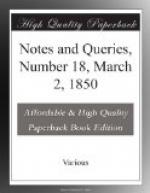8. Humboldt, in a paper which is translated in the Journal of the Royal Institution, vol. xxix.
I believe a good many other references might be made, with little trouble, to foreign Memoires; and (perhaps still more to your correspondent’s apparent purpose) to some amongst the Memoires that relate to inscriptions and topography, rather that amongst those relating directly to science or literature. However, the two parts of the subject cannot be effectively studied separately from each other; and I am not without a hope that these straggling notes may be of some use to “E.V.”
Under the view of inscriptions it occurs to my memory that in two or three places on the church of St. Brelade in Jersey, there are marked four vertical straight lines, which are interpreted by the natives to signify the Arabic numerals 1111; as the date MCXI of the building of the church. The church is evidently a very ancient one, and it is agreed to be the oldest in the island, and the island historians assign it to the early part of the 12th century. For these symbols being coeval with the building I do not vouch: as (though it is difficult to say what may constitute antiquity in the look of four parallel lines) I confess that to my eye they had “as modern a look” as four such lines could well have. The sudden illness of one of my party during our visit (1847), however, precluded my examining that beautiful spot and its interesting little church with the care I should have wished.
I may be allowed to suggest the necessity of some degree of caution in discussing this question: especially not to assume that any Arabic numerals which appear in ecclesiastical inscriptions are coeval with the dates they express; but rather inquire whether, from the condition of the stone bearing the inscription, these numbers may not have been put there at a later period, during repairs and alterations of the building itself. It is for many reasons improbable, rather than otherwise, that the Arabic numerals should have been freely used (if used at all) on ecclesiastical structures till long after the Reformation: indeed they are not so even yet.
But more. Even where there is authentic evidence of such symbols being used in ecclesiastical inscriptions, the forms of them will tell nothing. For generally in such cases an antique form of symbol would be assumed, if it were the alteration of a “learned clerk;” or the arabesque taste of the carver of the inscription would be displayed in grotesque forms. We would rather look for genuine than coeval symbols of this kind upon tombs and monuments, and the altar, than upon the building itself; and these will furnish collateral proofs of the genuineness of the entire inscriptions rather than any other class of architectural remains. The evidence of the inscriptions on “Balks and beams” in old manorial dwellings is especially to be suspected.
T.S.D.
Shooter’s Hill, Feb 11, 1850.




